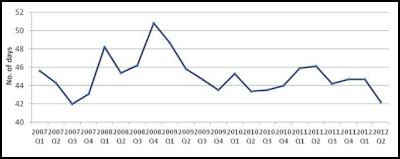Payment Days Fall To Pre-GFC Levels
Tuesday, 24 July 2012
Payment Days Fall To Pre-GFC Levels
New Zealand businesses are dramatically improving the time it takes to pay their bills, cutting average payment times to levels not seen since before the global financial crisis.
The latest Dun
& Bradstreet Trade Payments Analysis – which
examines the ability of firms to pay their bills, and pay
them on time – reveals average payment times dropped 2.6
days to 42.2 days during the June quarter to levels not
seen since the third quarter of 2007. Payment times were
also down by nearly four days over the past
year.
These figures align
with recent Treasury statistics* indicating a rebound in
economic growth following strong GDP gains in the March
quarter and post-earthquake reconstruction. Growth is
expected to continue in the second half of the year, despite
increased risks in the Euro-zone.
According to Dun & Bradstreet New Zealand General Manager, John Scott, improving payment times are a clear sign that businesses are benefiting from the economic recovery.
“Business-to-business payment data is one of the best indicators of cash flow and financial stability, as it reveals how a firm is meeting its existing financial obligations. Trade data shows that payment times began rising in late 2007, peaking at 51 days in Q4 2008 at the height of the crisis, before largely trending downwards over the next few years.”
“In particular, the last 12 months have seen businesses pay their bills significantly faster, providing further evidence of an improved trading environment,” Mr Scott said.
New Zealand
businesses are also performing better than their Australian
counterparts, with Aussie firms averaging payment times of
53.6 days during the quarter – a deterioration of nearly a
day since the March quarter 2012.
Average payment days, 2011 Q2
– 2012 Q2

Click for big version.
Further adding to New Zealand’s strong economic position, D&B’s analysis indicates that firms in all three major cities reduced their payment times, with Christchurch firms reporting the biggest year-on-year reduction of 6.3 days, to 41.8 days.
This brought payment times for Christchurch firms to their lowest level in three years, as compared to Wellington and Auckland-based firms, which cut payment times by four days year-on-year to 44.5 days and 43.5 days respectively.
The figures come as Statistics New Zealand reports a pickup in Christchurch retail activity. In addition, construction activity in the region has also risen by 34 per cent over the past 12 months.
“We are beginning to see the effects of the reconstruction process flow through to the business payment cycle of many Christchurch firms. As a result of this much-needed boost to the region’s economy, businesses are speeding up their bill payments and resuming business-as-usual operations,” Mr Scott said.
D&B’s analysis also indicates the improvement in payment times was evident across all sectors. This was particularly noticeable among firms in the traditionally slow-paying Communications sector, which significantly reduced the time taken to pay their bills by 8.7 days over the past 12 months — the biggest improvement of any industry.
Firms in the Utilities sector also recorded a notable improvement of six days year-on-year, followed by firms in the Agriculture sector (down 5.5 days)and by those in the Public Administration sector, which saw payment times fall by four days since the March quarter and over the past 12 months. However, firms in this sector were still the worst payers at 47.3 days.
Conversely, Agriculture and Forestry businesses maintained their ranking as the fastest payers; with payment times hovering around 37 days for each sector, following a bout of good growing weather and increased production levels in March. This was down 5.5 days and 2.8 days respectively year-on-year.
Firms of all sizes also improved payment times, with large firms (500+ employees) showing the biggest improvement of 5.3 days since the same quarter last year, although they remained the slowest payers at 45 days. Small businesses (less than 20 employees) were the fastest payers at 41.1 days, down 3.7 days year-on-year.
Despite the relatively strong position of New Zealand businesses, average payment times still remain above standard 30-day terms. According to Mr Scott, firms need to remain focused on business fundamentals.
“While New Zealand businesses enjoy some of the best operating conditions in the world, it is critical to remain focused on core elements of the business such as cash flow management. Regardless of a firm’s size or industry sector, cash flow is the lifeblood of any business operation and payment performance is a key part of sustaining that."
Note: D&B's trade payments analysis
utilises the accounts receivable records of New Zealand
firms. The D&B database contains more than eight million
current trade references in Australasia, which are analysed
and segmented by various demographics.
* For further information, please refer to the
New Zealand Treasury’s Monthly Economic Indicators June 2012,
published 29 June
2012.
ENDS


 Ngā Pae o te Māramatanga: Māori Concerns About Misuse Of Facial Recognition Technology Highlighted In Science
Ngā Pae o te Māramatanga: Māori Concerns About Misuse Of Facial Recognition Technology Highlighted In Science Retail NZ: Retailers Call For Flexibility On Easter Trading Hours
Retail NZ: Retailers Call For Flexibility On Easter Trading Hours WorkSafe NZ: Worker’s Six-Metre Fall Prompts Industry Call-Out
WorkSafe NZ: Worker’s Six-Metre Fall Prompts Industry Call-Out PSGR: Has MBIE Short-Circuited Good Process In Recent Government Reforms?
PSGR: Has MBIE Short-Circuited Good Process In Recent Government Reforms? The Reserve Bank of New Zealand: RBNZ’s Five Year Funding Agreement Published
The Reserve Bank of New Zealand: RBNZ’s Five Year Funding Agreement Published Lodg: Veteran Founders Disrupting Sole-Trader Accounting in NZ
Lodg: Veteran Founders Disrupting Sole-Trader Accounting in NZ



